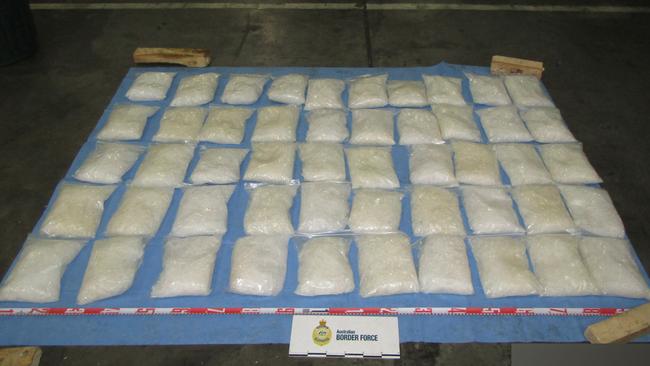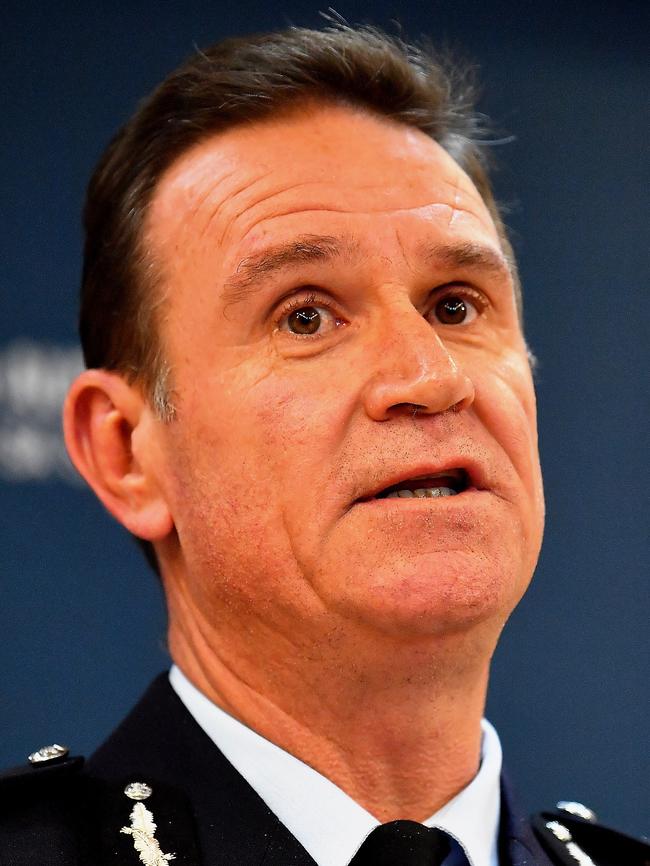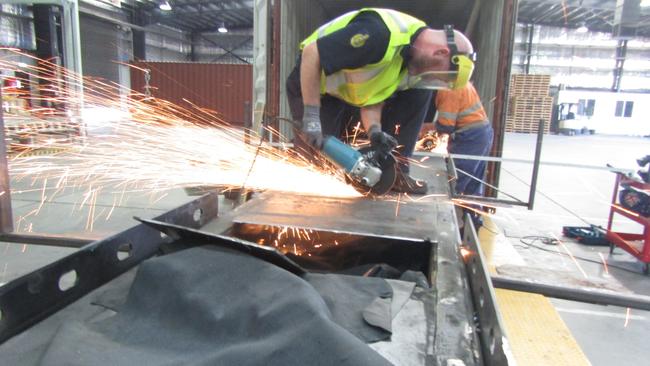True Crime Australia: The notorious expat bikies and their South Australian drug empires
THEY are the infamous bikies who have abandoned Australia — but law enforcement believe they are among the kingpins behind the drug epidemic flooding our streets and crippling South Australia’s rural communities.
True Crime
Don't miss out on the headlines from True Crime. Followed categories will be added to My News.
- ANALYSIS: Adelaide is Australia’s methamphetamine capital
- OUR ICE SCOURGE: More workers turning up to work on drugs
NOTORIOUS ex-Adelaide bikies now living overseas are believed to be some of the kingpins behind the ice epidemic flooding the state and crippling rural communities.
Senior police have revealed the state’s insatiable appetite for methamphetamines — Adelaide was recently named the ice capital of Australia — is being satisfied almost exclusively by several criminal syndicates importing huge quantities of the drug.
At least two of the syndicates are controlled by expatriate Adelaide bikies.
They have close links to well-known local crime figures and gangs who manage distribution of the imported drugs.
Senior police believe the syndicates spend significant amounts of their profits on “research and development’’ programs to devise new methods of hiding large methamphetamine shipments — and to export millions of dollars in cash following their sale.
While some methamphetamine traffickers manufacture small quantities in makeshift backyard laboratories, the sheer quantity of ice now being consumed locally has resulted in a dramatic switch in tactics by organised crime figures to meet demand.
Australian Federal Police SA commander Peter Sykora said while there had been several notable seizures in SA of significant quantities over the past 18 months, the drug was still being smuggled into SA undetected.
“We know that a lot of narcotics are coming through to Australia. I think when you have a look at the wastewater data, 8.4 tonnes is being used on an annual basis and yet the seizure rate does not reflect that, so there is a lot more coming through then we are actually seizing,’’ he said.
“And for every seizure and arrest we are making, there is always somebody there to replace the syndicate or individual we are taking out.
“That’s because Australia is such a lucrative market, and I think this is the key — we are paying the highest price for methamphetamine than any other country in the world.”
To clearly illustrate the super profits being made by the syndicates importing the drug and mid-level traffickers, the latest police intelligence reveals users are paying between $50 and $100 for a point of ice — 0.1 gram — which typically lasts just a day.
At that price, traffickers are making up to $1 million per kilogram of ice that they have paid between $75,000 and $125,000 for wholesale.
The Australian Criminal Intelligence Commission’s national wastewater monitoring report released in March indicated almost 8.4 tonnes of methamphetamines was consumed nationally last financial year.
It also showed the amount of methylamphetamine used in regional SA doubled between August and December.
In 2017, Federal Police seized almost 4.4 tonnes of ice nationally — more than double the figure of 1.94 tonnes seized in 2013.
So far this year, 1.9 tonnes has been seized.
It is likely SA’s share of the ACIC consumption figure is considerably more than 15 per cent, meaning more than a tonne of the drug is reaching SA’s streets annually to sustain the current demand of users.
Commander Sykora said the majority of the shipments were entering Australia via the eastern seaboard before making their way to SA.
The largest seizure in SA, 313kg concealed in crane jibs in February this year, entered Australia via Melbourne.
While coy about identifying the key players in the networks in SA, Commander Sykora revealed outlaw motorcycle gangs were still a significant issue “around the country for us and here in SA’’.
“They do not work in isolation, they work with other organised crime syndicates. They have got the same partnerships from an illegal point of view as we have with our law enforcement partners,’’ he said.
“We have a very good picture of crime here in SA and who the main players are, but that is not say we know absolutely every player. But we do know who the major organised crime syndicates are that operate here in SA.’’

An insight into those involved in one operation came to light in the District Court last year in a bail application for one of the men arrested in connection with the seizure of 113kg of ice concealed in machinery stands at a property owned by a well-known Adelaide bikie.
In that hearing, prosecutors revealed the identities of several men connected to the charged trio.
The men are members of the Descendants bikie gang with strong links to the suspected mastermind of the importation, an ex-Adelaide bikie who lives overseas.
It came as no surprise to police the syndicate was using the same methods to smuggle cash out of Australia as was being used to import the ice.
More than $1.5 million in cash was seized after being discovered hidden in identical machinery stands awaiting export as part of the operation.
The three men charged over the record 313kg seizure in February are also linked to an outlaw bikie gang.
Commander Sykora said while small quantities of precursor chemicals used to manufacture ice were still imported, it was now cheaper to import the finished product in bulk because of the huge volume needed to supply demand.
While a considerable amount of the methamphetamine entering Australia is dispatched from China — especially the Guandong Province — it also emanates from selected European countries, Asia, Mexico and US.
The AFP works closely with those jurisdictions to stop the narcotics leaving their shores with operations established in each location — Strike Force Dragon in Cambodia, Taskforce Storm in Thailand and Taskforce Blaze in China.

Taskforce Blaze, which was initiated in 2015, has alone resulted in 13 tonnes of ice and precursor chemicals being seized in China and Australia and the arrest of 215 people — 117 in China and 98 in Australia.
Commander Sykora said while police were doing their best to stem the flow of drugs, the demand also had to be addressed as part of the solution.
“We are disrupting a lot of the importations with the help of our overseas partners, but we still need to battle with the demand aspect,’’ he said.
“We have a role at the table, but this is about health and education, really getting to know why our communities at a state and national level why they are taking narcotics, particularly methamphetamine.
“More needs to be done from the demand angle with health and education and really have a look at how we reduce the demand for narcotics, not just methamphetamines.’’
Commander Sykora said it was no surprise that the concealment methods used in last two major shipments to SA — 313kg and 113kg — were far more elaborate and planned than others previously seen.
“What that says to me is that the organised crime syndicates have really evolved,’’ he said.
“I firmly believe the money they gain from their sale, the profits they reap, they put a percentage into research and development so they can work out the best ways of getting those drugs through our borders.
“We are getting a lot better at detecting them, but I can say they are getting better too, at concealment methods.’’

While the AFP takes the lead on most major importations, the syndicates are targeted in close consultation with SAPOL, Australian Border Force and the ACIC.
The head of the ACIC’s Drug Intelligence Hub, Shane Neilson, said the wastewater consumption figures were not a complete surprise.
“It does paint a picture, not just in SA but nationally, of the insidious problem that methamphetamine poses.”
Mr Neilson said local laboratories did contribute to the problem but not to the extent they did five or so years ago.
Factors influencing this trend included the tightening of the availability of precursors and the fact there is less risk importing the finished product in bulk than running the gauntlet of importing significant quantities of chemicals and then manufacturing it.
“It would appear organised crime groups made a business decision to put their resources into importation,’’ he said.
“It is sobering. Clearly those drugs were replaced so that is the scope of the challenge facing law enforcement.”
As part of its covert operations, the ACIC maintains a secret target list that comprises the “who’s who’’ of organised criminals in Australia.
“There are significantly more than 50 per cent of the people on the national target list in the illicit drug trade in one or more drug markets,’’ Mr Neilson said.
While SA police are still detecting a significant number of clandestine drug laboratories, relatively few are manufacturing ice.
Instead, they involve drugs such as fantasy or the refining of cannabis oil. Last financial year, 78 were detected, compared with 69 this financial year.
Assistant Commissioner (Crime) Scott Duval attributed this to two factors — the large number of source countries that can now produce vast quantities of ice cheaply and the difficulty local criminals are having sourcing the required precursor chemicals.
He said the sheer size of the ice shipments now arriving in SA was “concerning’’.
“What it is doing is satisfying a demand. We are at one end of the chain; if there is that amount of drugs coming in, there has to be a demand,’’ he said.
“What we have to do is collectively reduce the demand because if that drops off, so does the volume. It is an issue for all of us.’’
While not dismissing the wastewater statistics, police believe they may be somewhat slanted because of the large number of testing stations locally, compared with other states.
“I think you have to take it in context,’’ Mr Duval said.
“If you look at that volume, that is really concerning because it again comes back to demand. It may not be entirely accurate but it gives us a far better picture of consumption than previous surveys have done.’’
He said policing strategies had been working around the testing locations, particularly in regional areas.
Evidence of this activity emerged when a police operation targeting ice trafficking in the South-East resulted in the arrest of eight men.
But while a heavy emphasis is placed on enforcement and disruption of the trafficking syndicates, police realistically know they simply have no hope of arresting their way out of the current problem.
Reducing demand for the drug through education, treatment programs and harm awareness is the key to stemming the rise in importations.
“It is one thing to educate, but there does need to be the programs available for people who want to get off using, too,’’ Mr Duval said.
He said there were similarities to the heroin glut in the mid-1980s when its use was out of control, large amounts were imported there were record numbers of overdoses.
“We saw a turnaround in that through a range of programs. I guess if you wind the clock forward, what is different with the discussions we had around that drug?’’ he said.
“There is still a lot of hope.’’
Originally published as True Crime Australia: The notorious expat bikies and their South Australian drug empires
